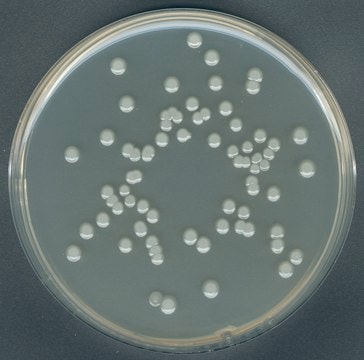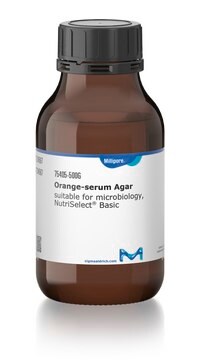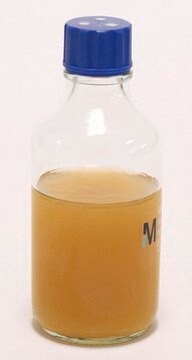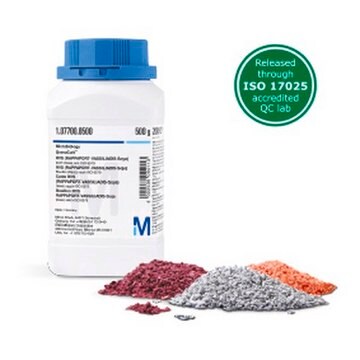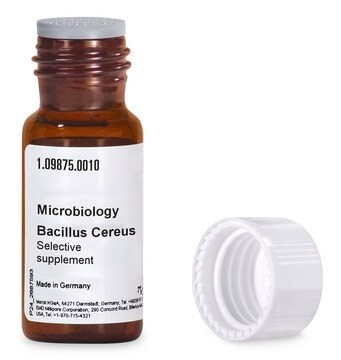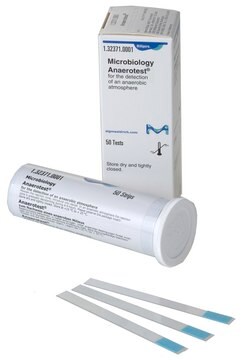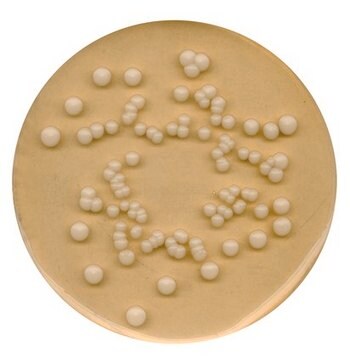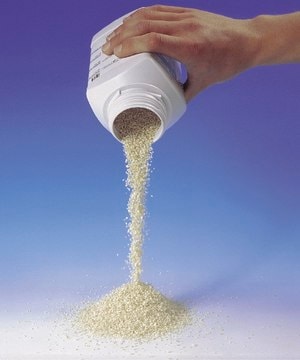1.10673
Orange Serum agar
GranuCult®, according to IFU, suitable for microbiology, for yeasts, for molds
Sign Into View Organizational & Contract Pricing
All Photos(2)
About This Item
UNSPSC Code:
41106213
Recommended Products
agency
according to IFU
Quality Level
form
medium granules (dehydrated (DCM))
packaging
pkg of 500 g
manufacturer/tradename
GranuCult®
storage condition
protect from light (Keep tightly closed and dry)
technique(s)
microbiological culture: suitable
color
beige
pH
5.4-5.6 (37 °C, 42 g/L in H2O, after autoclaving)
solubility
42 g/L
bulk density
700 kg/m3
application(s)
food and beverages
microbiology
storage temp.
15-25°C
suitability
molds
yeasts
Related Categories
General description
Orange Serum Agar is developed specifically to isolate and enumerate the microorganisms that can spoil citrus fruit beverages. Due to its low pH, citrus fruit juices are susceptible to spoilage, mainly by molds, yeasts, and acidophilic bacteria such as Lactobacillus and Leuconostoc. Orange Serum Agar is recommended by APHA for the examination of fruit beverages. Casein peptone and yeast extract provide essential nitrogenous and carbonaceous nutrients and vitamin B complex. Glucose is added as a carbon and energy source. Orange extract generates an optimal environment for the enrichment of acid-tolerant microorganisms from citrus fruit samples. Dipotassium hydrogen phosphate acts as buffering substance.
Application
Orange Serum agar is suitable for the isolation, cultivation, and enumeration of acid-tolerant spoilage microorganisms in fruit juice and fruit juice concentrates from citrus fruit.
Features and Benefits
- GranuCult® offers superior granulated culture media
- Safe and sustainable due to reduced risks associated with fine dust and toxic substance inhalation, resulting in a safer work environment
- Excellent wettability, solubility, and free-flowing properties
- Convenient, with minimal component separation and clumping, even under warm or humid conditions
- High batch-to-batch reproducibility
- Prolonged shelf life of up to five years
- High number of test strains exceeding all regulatory demands
- Granulation technology allows many supplements to be included, with no need to add these separately
Analysis Note
Appearance (clearness): clear to opalescent
Appearance (color): yellowish to yellowish-brown
pH-value (25 °C): 5.4 - 5.6
Growth promotion test in accordance with the current version of DIN EN ISO 11133.
Inoculum on reference medium (Bacillus cereus ATCC 11778 (WDCM 00001)):
Inoculum on reference medium(Lactobacillus plantarum ATCC 14917 (WDCM 00104)):
Inoculum on reference medium (Lactobacillus casei ATCC 393 (WDCM 00100)):
Inoculum on reference medium(Leuconostoc mesenteroides ATCC 9135 (WDCM 00108)):
Inoculum on reference medium (Candida albicans ATCC 10231 (WDCM 00054)):
Colony count (Bacillus cereus ATCC 11778 (WDCM 00001)):
Colony count (Lactobacillus plantarum ATCC 14917 (WDCM 00104)):
Colony count (Lactobacillus casei ATCC 393 (WDCM 00100)):
Colony count (Leuconostoc mesenteroides ATCC 9135 (WDCM 00108)):
Colony count (Candida albicans ATCC 10231 (WDCM 00054)):
Recovery on test medium (Bacillus cereus ATCC 11778 (WDCM 00001)): ≥ 70 %
Recovery on test medium (Lactobacillus plantarum ATCC 14917 (WDCM 00104)): ≥ 70 %
Recovery on test medium (Lactobacillus casei ATCC 393 (WDCM 00100)): ≥ 70 %
Recovery on test medium (Leuconostoc mesenteroides ATCC 9135 (WDCM 00108)): ≥ 70 %
Recovery on test medium (Candida albicans ATCC 10231 (WDCM 00054)): ≥ 70 %
Growth (Aspergillus brasiliensis (formerly A. niger) ATCC 16404 (WDCM 00053)): good to very good
Incubation: 4 days at 26 ± 2 °C, aerobic
A recovery rate of 70 % is equivalent to a productivity value of 0.7.
The indicated colony counts result from the sum of a triple determination.
Reference media: Tryptic Soy Agar resp. SABOURAUD agar
Appearance (color): yellowish to yellowish-brown
pH-value (25 °C): 5.4 - 5.6
Growth promotion test in accordance with the current version of DIN EN ISO 11133.
Inoculum on reference medium (Bacillus cereus ATCC 11778 (WDCM 00001)):
Inoculum on reference medium(Lactobacillus plantarum ATCC 14917 (WDCM 00104)):
Inoculum on reference medium (Lactobacillus casei ATCC 393 (WDCM 00100)):
Inoculum on reference medium(Leuconostoc mesenteroides ATCC 9135 (WDCM 00108)):
Inoculum on reference medium (Candida albicans ATCC 10231 (WDCM 00054)):
Colony count (Bacillus cereus ATCC 11778 (WDCM 00001)):
Colony count (Lactobacillus plantarum ATCC 14917 (WDCM 00104)):
Colony count (Lactobacillus casei ATCC 393 (WDCM 00100)):
Colony count (Leuconostoc mesenteroides ATCC 9135 (WDCM 00108)):
Colony count (Candida albicans ATCC 10231 (WDCM 00054)):
Recovery on test medium (Bacillus cereus ATCC 11778 (WDCM 00001)): ≥ 70 %
Recovery on test medium (Lactobacillus plantarum ATCC 14917 (WDCM 00104)): ≥ 70 %
Recovery on test medium (Lactobacillus casei ATCC 393 (WDCM 00100)): ≥ 70 %
Recovery on test medium (Leuconostoc mesenteroides ATCC 9135 (WDCM 00108)): ≥ 70 %
Recovery on test medium (Candida albicans ATCC 10231 (WDCM 00054)): ≥ 70 %
Growth (Aspergillus brasiliensis (formerly A. niger) ATCC 16404 (WDCM 00053)): good to very good
Incubation: 4 days at 26 ± 2 °C, aerobic
A recovery rate of 70 % is equivalent to a productivity value of 0.7.
The indicated colony counts result from the sum of a triple determination.
Reference media: Tryptic Soy Agar resp. SABOURAUD agar
Footnote
We offer two media types: the superior granulated GranuCult® and the cost-efficient powdered NutriSelect® culture media, depending on your needs.
The designations basic, plus, or prime are added to indicate the quality control level, from basic quality control to standard QC plus to prime for full regulatory compliance.
The designations basic, plus, or prime are added to indicate the quality control level, from basic quality control to standard QC plus to prime for full regulatory compliance.
Legal Information
GRANUCULT is a registered trademark of Merck KGaA, Darmstadt, Germany
NutriSelect is a registered trademark of Merck KGaA, Darmstadt, Germany
Storage Class
11 - Combustible Solids
wgk_germany
WGK 3
Certificates of Analysis (COA)
Search for Certificates of Analysis (COA) by entering the products Lot/Batch Number. Lot and Batch Numbers can be found on a product’s label following the words ‘Lot’ or ‘Batch’.
Already Own This Product?
Find documentation for the products that you have recently purchased in the Document Library.
Our team of scientists has experience in all areas of research including Life Science, Material Science, Chemical Synthesis, Chromatography, Analytical and many others.
Contact Technical Service